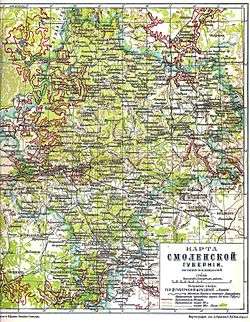Smolensk Governorate
| Smolensk Governorate Смоленская губерния | |||||
| Governorate of Russian Empire | |||||
| |||||
|
Coat of arms | |||||
 | |||||
| Capital | Smolensk | ||||
| History | |||||
| • | Established | 1796 | |||
| • | Disestablished | January 14, 1929 | |||
| Population | |||||
| • | 1897 | 1,525,279 | |||
Smolensk Governorate (Russian: Смоленская губерния), or the Government of Smolensk, was an administrative division (a guberniya) of the Tsardom of Russia, the Russian Empire, and the Russian SFSR, which existed, with interruptions, between 1708 and 1929.
Smolensk Governorate, together with seven other governorates, was established on December 29 [O.S. December 18], 1708, by Tsar Peter the Great's edict.[1] As with the rest of the governorates, neither the borders nor internal subdivisions of Smolensk Governorate were defined; instead, the territory was defined as a set of cities and the lands adjacent to those cities.[2]
History
On July 28 [O.S. July 17], 1713, Smolensk Governorate was abolished and its territory was divided between Moscow and Riga Governorates. The governorate was re-established in 1726. In 1775, it was included, along with parts of Moscow and Belgorod Governorates, into Smolensk Vice-Royalty. The governorate was again restored in 1796.
After the October Revolution, Smolensk Governorate was base of independent Western Oblast/Western Commune, Soviet Socialist Republic of Belarus, Lithuanian–Belorussian Soviet Socialist Republic (Litbel), and finally incorporated into the Russian SFSR.
Eventually, on January 14, 1929, Smolensk Governorate was abolished and its territory was included into Western Oblast.
Subdivisions
| # | City | # | City | # | City |
|---|---|---|---|---|---|
| 1. | Smolensk | 7. | Meshchevsk | 13. | Serpeysk |
| 2. | Belyaya | 8. | Mosalsk | 14. | Staritsa |
| 3. | Borisovo Gorodishche | 9. | Odoyev | 15. | Vorotynsk |
| 4. | Dorogobuzh | 10. | Peremyshl | 16. | Vyazma |
| 5. | Kozelsk | 11. | Pogoreloye Gorodishche | 17. | Zubtsov |
| 6. | Likhvin | 12. | Roslavl |
Demography
Language
- Population by mother tongue according to the Imperial census of 1897.
| Language | Number | percentage (%) | males | females |
|---|---|---|---|---|
| Russian | 1,397,875 | 91.6 | 655,460 | 742,415 |
| Belarusian | 100,757 | 6.6 | 48,663 | 52,094 |
| Jewish | 10,903 | 0.7 | 6,049 | 4,854 |
| Polish | 7,314 | 0.5 | 4,855 | 2,459 |
| Latvian | 3,485 | 0.2 | 1,770 | 1,715 |
| German | 1,727 | 0.1 | 879 | 848 |
| Ukrainian | 1,374 | 0.0 | 1,247 | 127 |
| Gypsy | 661 | 0.0 | 338 | 323 |
| Estonian | 301 | 0.0 | 158 | 143 |
| Tatar | 291 | 0.0 | 281 | 10 |
| Lithuanian | 255 | 0.0 | 226 | 29 |
| Other | 336 | 0.0 | 190 | 146 |
| Total | 1,525,279 | 100.0 | 720,116 | 805,163 |
Religion
- According to the Imperial census of 1897.[3]
| Religion | Number | percentage (%) | males | females |
|---|---|---|---|---|
| Pravoslavs[4] | 1,480,110 | 97.0 | 696,506 | 783,604 |
| Old Believers and others split from Pravoslavs | 20,728 | 1.4 | 9,164 | 11,564 |
| Judaism | 11,144 | 0.7 | 6,186 | 4,958 |
| Roman Catholic | 8,487 | 0.6 | 5,631 | 2,856 |
| Lutherans | 4,303 | 0.3 | 2,218 | 2,085 |
| Islam | 294 | 0.0 | 283 | 11 |
| Reformed | 83 | 0.0 | 50 | 33 |
| Karaites | 41 | 0.0 | 25 | 16 |
| Armenian Gregorians | 11 | 0.0 | 7 | 4 |
| Anglicans | 9 | 0.0 | 3 | 6 |
| Armenian Catholic Church | 3 | 0.0 | 1 | 2 |
| Mennonites | 2 | 0.0 | 1 | 1 |
| Other: Christian denominations | 50 | 0.0 | 30 | 20 |
| Other: non-Christians | 6 | 0.0 | 6 | 0 |
| Total | 1,525,279 | 100.0 | 720,116 | 805,163 |
References
- 1 2 Указ об учреждении губерний и о росписании к ним городов (Russian)
- ↑ С. А. Тархов (2001). "Изменение административно-территориального деления России за последние 300 лет". Электронная версия журнала "География".
- ↑ Religion Statistics of 1897 (Russian)
- ↑ Eastern Orthodox, including Russian Orthodox, Greek Orthodox, and Georgian Orthodox
Further reading
- Голубовский П. В. (1895) История Смоленской земли до начала XV столетия (History of the Smolensk land prior to the beginning of the 15th century) (Russian)
Coordinates: 54°46′58″N 32°02′43″E / 54.7828°N 32.0453°E
